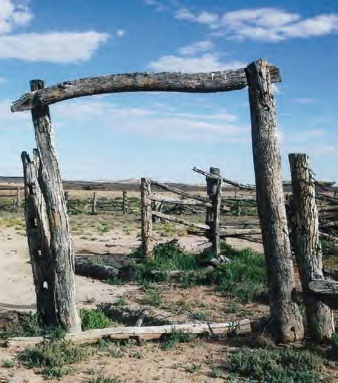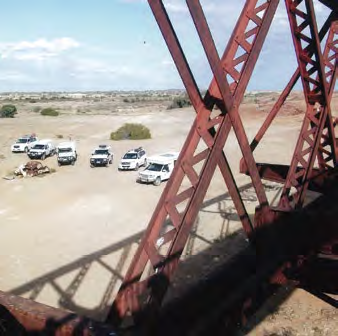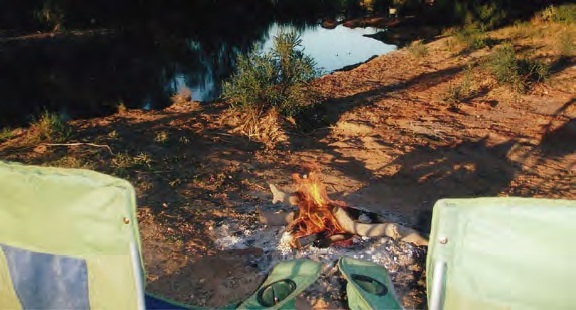
Can we restore it?
in June 2012 my husband John and I travelled with a group of friends in six 4x4 vehicles down the Old Ghan Track. We met in Alice Springs and saw a little of the town including a great street market featuring local crafts people, and being a crafts person myself I appreciated the work that had gone into some of their wares.
We started out immediately after the Finke Desert Race and drove out to Chambers Pillar for lunch. One must wonder at the forces of nature. The Track was very corrugated, with old rail spikes exposed in parts, and we were quite disgusted by the amount of rubbish left behind by campers and spectators who had been out watching the race, but fortunately we were able to find a good clean camp area left by more responsible campers, even a convenient pile of firewood, which we made good use of even though we carry our own.
Our second day took us out to the Old Andado Homestead and the Mac Clark Conservation Reserve – the site of some of Australia’s rarest trees (Acacia peuce) reputed to be over 700 years old. That night we made camp at the old Homestead and looking through the house was a real history lesson. Here we were visited by flocks of Major Mitchells and zebra finches.

Beresford Siding
Then we followed Binns Track, sand hills, mulga scrub, birds and animals, to Mt. Dare – a surprisingly busy place, then on to Dalhousie Springs. I was amazed by the amount of water and how warm it was, so a swim to wash off the day’s dust was appreciated. Early the next morning we were visited by some dingoes that I could hear but not see.
Travelling on we visited the Dalhousie and Pedrika Ruins. The Track consistently changes – corrugations, gravel, stones, sand and creek crossings, making driving interesting to say the least. On past Hamilton, Oodnadatta and an old rail crossing, to make camp at Algebuckina Rail Bridge over the Neales River. Again there was quite a lot of water and the bridge made it an interesting and picturesque place with plenty to see and do. One of our group went for a swim, but I declined as it looked rather muddy and slippery under foot. In the morning I spent some time watching the pecking order of the birds wanting to perch along the bridge – hawks, crows, Murray larks, galahs, cormorants and others. I could have easily spent more time here to relax and wind down but the group moved on, travelling out to the ruins of the old Peake Overland Telegraph Station, where one could spend all day poking around all the ruins in the area.

Pedrika Siding
Back on the highway we were able to help out a lady travelling with four children. She had a blowout and could not get the lock nuts off her spare tyre (something to think about!). She travelled with us to William Creek and was heading to Roxby Downs. We made camp at the Beresford Siding ruins and waterhole; as the roof was still on, one of the couples slept in one of the rooms here instead of pitching their tent.
The next day we visited Coward Springs. The museum was interesting especially since the grandfather of a friend of mine was born there – his father was the publican. We then visited the fascinating mound springs – The Bubbler and Blanche Cup’, Curdimurka Siding, past Lake Eyre South and in to Marree before heading north to make camp at the Muloorina Station camp and billabong. This was another great spot to relax and watch the bird and animal life.

Algebuckina Bridge
Back to Marree and the group wondered about the funny black stuff all over the road. We lunched at the campground at the Farina ruins – another interesting area. Next we travelled through Lyndhurst and Copley (and the bakery) to spend the night at Leigh Creek.
The road to Aroona Dam was closed, so on to Beltana where some buildings are in ruins but some are still being lived in. Past Sliding Rock to Warraweena. No-one was around and the gates were locked to our proposed tracks, so back out to Parachilna, then in to camp at Moolooloo, the Oratunga Creek showed signs of a recent high flood.

Camp, Old Ghan Track, north of Finke
Now we are in typical Flinders Ranges country that I love. We visited the old Nuccaleena Mine site, then with many watery creek crossings through Hannigan’s Gap to Artimore ruins and out to Blinman and Hawker. Here we had our last camp and farewell dinner at the local pub.
For the whole of our trip the weather was perfect with mild days and cool nights. We elected to stay on here for three more nights – and guess what? It poured with rain! Heading for home we stopped at the Hammond Memorial and visited the old Amyton Cemetery. This is the area my family settled in after emigrating from England in the 1800s. We then visited a niece in Wilmington.

William Creek
It has been a trip full of wonder at the hardships endured and the tenacity and perseverance of our early settlers in these remote areas, and we are so grateful that we can visit so easily now.

Muloorina Billabong
Category: Unknown
Written: Wed 01 May 2013
Printed: May, 2013
Published By:
Dawn Bon S64875